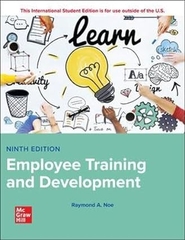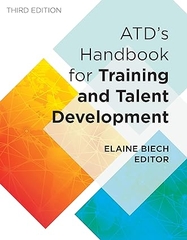-
-
-
Tổng tiền thanh toán:
-
-
Thông tin
-
Tìm sách theo yêu cầu
This book covers the essentials of needs analysis from the emerging trainer's perspective by providing just the right amount of support and knowledge without going too deep into the subject. The topics covered include when and how to do a training needs analysis; using informal and formal analysis techniques; goal, task and population analysis; and how to develop and present a training plan for management approval. Each chapter includes appropriate data gathering tools. The Skilled Trainer series provides practical guidance for those who've had some exposure to training and would like to take their career to the next level.
Product Details
- Paperback: 192 pages
- Publisher: Pfeiffer (January 20, 2006)
- Language: English
- ISBN-10: 0787975257
- ISBN-13: 978-0787975258
- Product Dimensions: 9.2 x 6.9 x 0.5 inches
- Shipping Weight: 13.6 ounces (View shipping rates and policies)
- Average Customer Review: 4.6 out of 5 stars See all reviews (5 customer reviews)
- Amazon Best Sellers Rank: #62,988 in Books (See Top 100 in Books)
- #67 in Books > Business & Money > Management & Leadership > Training
Editorial Reviews
Review
"This is a very handy book to own if one is working in the area of training or performance management." It is particularly suitable for those who are new to the training function and is valuable for students in human factors." (PsycCritiques, 9/5/2007)
Review
"In this volume, Jean Barbazette--a true training pro--shares her tips and tricks for conducting a training needs assessment. Theoretically sound, yet infinitely practical, Barbazette guides trainers through each phase of a needs assessment, from starting the process to reporting the data to management. This book is an essential tool for both trainers who need to learn about needs assessment on-the-job, and students in academic courses on instructional design, needs assessment, and training."
--Saul Carliner, Ph.D., CTDP, assistant professor, Graduate Program in Educational Technology, Concordia University, Montreal, Quebec, Canada
--Saul Carliner, Ph.D., CTDP, assistant professor, Graduate Program in Educational Technology, Concordia University, Montreal, Quebec, Canada
Most Helpful Customer Reviews
11 of 11 people found the following review helpfulBy Machelle Ford Ferry on January 23, 2008
Format: Paperback Verified Purchase
Comment Was this review helpful to you? YesNoThe methods introduced in this book are simply put, easy to follow and a complete guide to perform a Training Needs Assessment.
The book begins with breaking down who, what, when, why and how of an assessment. It introduces the issue that training is not always the solution to a deficiency and how to identify if there is a need for training or a need for another solution.
There are seven different analyses broken down into separate chapters to guide you in conducting successful analyses.
Feasibility Analysis- The cost of doing something verses the cost of doing nothing to correct a deficiency.
Performance Analysis- Also known as a gap analysis, a look at where your employees are and where you would like them to be.
Goal Analysis - Includes how to write a goal statement. Breaking down vague statements into specific behaviors desired by a company for succes
Task Analysis - The book will guide you in breaking down tasks within a job.
Needs versus Wants Analysis - Why should training be done? Is the deficiency tied to a need or a want? Again looking at finding the proper solution.
Target Population - How to develop an effective training program for the audience. How to identify the audience.
Contextual Analysis - How and when to deliver training successfully.
One very interesting point covered is to always deal with the decision maker during every processes. This will save time and money (yours).
Overall, a complete guide to successful analyses.
The book begins with breaking down who, what, when, why and how of an assessment. It introduces the issue that training is not always the solution to a deficiency and how to identify if there is a need for training or a need for another solution.
There are seven different analyses broken down into separate chapters to guide you in conducting successful analyses.
Feasibility Analysis- The cost of doing something verses the cost of doing nothing to correct a deficiency.
Performance Analysis- Also known as a gap analysis, a look at where your employees are and where you would like them to be.
Goal Analysis - Includes how to write a goal statement. Breaking down vague statements into specific behaviors desired by a company for succes
Task Analysis - The book will guide you in breaking down tasks within a job.
Needs versus Wants Analysis - Why should training be done? Is the deficiency tied to a need or a want? Again looking at finding the proper solution.
Target Population - How to develop an effective training program for the audience. How to identify the audience.
Contextual Analysis - How and when to deliver training successfully.
One very interesting point covered is to always deal with the decision maker during every processes. This will save time and money (yours).
Overall, a complete guide to successful analyses.
Format: Paperback
Comment Was this review helpful to you? YesNoOther books I considered purchasing on this topic require interpretation of the content or demand a Masters degree in Organizational Development to understand the author's point. Barbazette avoids those traps and instead offers useful methods and tools in a format I found easy to read and easy to implement. Given the multiple ways I have applied what I learned from the book, I consider this book one of my best purchases in the last twelve months.
19 of 22 people found the following review helpfulBy John Matlock on June 21, 2006
Format: Paperback
Comment Was this review helpful to you? YesNoFirst is the collection of information. In order to proceed with any kind of training some information needs to be determined before you can even decide that training is needed. And if it is, what kind of training. Perhaps this is product training for the sales people. Perhaps it is time management. Perhaps the problem being addressed doesn't call for more training but some kind of change in the work flow, the people, or the computer system.
Second is the analysis of the collected information. This may be summaries, complete with charts and tables; this may find something so obvious that you will wonder how it was missed. The end of this phase is to present to the management requesting the study to determine what, if any training is needed.
Finally is the development of a training plan. The author presents a ten part plan that begins with Issue Definition, and ends with an evaluation of the results of the training. These steps have been defined over many years and are a proven approach.
A CD is supplied with the book that includes forms, checklists and other tools that are referenced in the book itself.
Second is the analysis of the collected information. This may be summaries, complete with charts and tables; this may find something so obvious that you will wonder how it was missed. The end of this phase is to present to the management requesting the study to determine what, if any training is needed.
Finally is the development of a training plan. The author presents a ten part plan that begins with Issue Definition, and ends with an evaluation of the results of the training. These steps have been defined over many years and are a proven approach.
A CD is supplied with the book that includes forms, checklists and other tools that are referenced in the book itself.
1 of 1 people found the following review helpfulBy Edwin C. Pauzer VINE VOICE on March 19, 2013
Format: Paperback
In the world of business many mistakes, miscalculations and failures, training is seen as the problem and the solution, but author and training consultant Jean Barbizette demonstrates in clear, straightforward language the need for a sound needs assessment to avoid the pitfalls of going off in the wrong direction that will cost time, money, and productivity. Training is a solution, not a problem unless it is misused. She insists that a needs assessment must consist of three steps: gathering information, analyzing information, and creating a training plan. That means basic questions of who, what, why, where, when and how must be answered in seven analytical processes:
Performance analysis: what are they doing wrong and identifying the most cost/effective solution
Feasibility analysis: essentially is it worth it--why should the training be done
Needs vs. wants analysis: perhaps the greatest pitfall of all--why should the training be done
Goal analysis: what specific behavioral improvement is required
Job/task analysis: what is the best way to do a task and how to break down a task into its parts
Target population: analysis who must be trained and
Contextual analysis: when and how to deliver the training
While these analyses might seem daunting to the training neophyte, there are a number of templates that will guide the person through each process. I found a simple four-box matrix of Will/Won't Do's, Can/Can't Do's as a means of instructing others in when training is and isn't appropriate, to be most helpful. It is much easier for people to grasp than Mager's Performance Analysis Flow Chart. Her book also comes with a CD that offers templates, tools and methods.Read more ›
Performance analysis: what are they doing wrong and identifying the most cost/effective solution
Feasibility analysis: essentially is it worth it--why should the training be done
Needs vs. wants analysis: perhaps the greatest pitfall of all--why should the training be done
Goal analysis: what specific behavioral improvement is required
Job/task analysis: what is the best way to do a task and how to break down a task into its parts
Target population: analysis who must be trained and
Contextual analysis: when and how to deliver the training
While these analyses might seem daunting to the training neophyte, there are a number of templates that will guide the person through each process. I found a simple four-box matrix of Will/Won't Do's, Can/Can't Do's as a means of instructing others in when training is and isn't appropriate, to be most helpful. It is much easier for people to grasp than Mager's Performance Analysis Flow Chart. Her book also comes with a CD that offers templates, tools and methods.Read more ›
XEM THÊM TẠI AMAZON.COM
- Thông tin chi tiết
- Mục lục
- Đọc thử
- Đọc thử
- Đánh giá & bình luận của người mua
- Những cuốn sách cùng chủ đề hoặc có liên quan
Link: http://www.amazon.com/Training-Needs-Assessment-Methods-Techniques/dp/0787975257/
Tại web chỉ có một phần nhỏ các đầu sách đang có nên nếu cần tìm sách gì các bạn có thể liên hệ trực tiếp với Thư viện qua Mail, Zalo, Fanpage nhé
Đăng ký nhận tin qua email
Hãy đăng ký ngay hôm nay để nhận được những tin tức cập nhật mới nhất về sản phẩm và các chương trình giảm giá, khuyến mại của chúng tôi.












